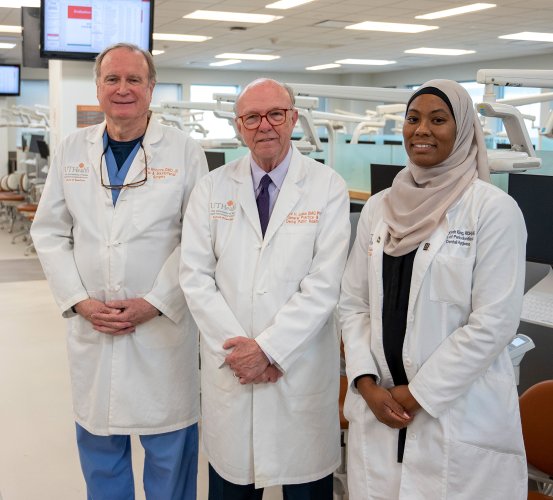Dental Hygiene Local Infiltration Anesthesia Course celebrates one year of instruction
Published: July 25, 2025 by Dylan Allen and Kyle Rogers

One year after a landmark rule change expanded the scope of practice for dental hygienists in Texas, UTHealth Houston School of Dentistry is celebrating the success of its continuing education course designed to certify dental hygiene professionals in the administration of local infiltration anesthesia.
On May 2, 2024, the Texas State Board of Dental Examiners voted to adopt Rule 115.10, which allowed dental hygienists to administer local infiltration anesthesia in Texas. Following proper training in local anesthesia, registered dental hygienists must obtain a state certification to administer local anesthesia.
To meet that need, the PACE Center at UTHealth Houston School of Dentistry launched a two-part continuing education program. The 20-hour didactic course began July 15, followed by an in-person, 12-hour hands-on training on Sept. 20. Since then, hands-on sessions have been held regularly at the dental school.
The online didactic course serves as a prerequisite for the hands-on training that gives attendees practical experience related to the administration of local anesthesia. The hands-on component includes a review of anatomy and neuroanatomy of dental local anesthesia, high-fidelity simulation, and live patient injections.
The course directors are School of Dentistry faculty members Arthur Jeske, DMD, PhD; Clark Whitmire, DMD, JD; and Sumayyah King, RDH, MS.
Since its launch, the PACE Center has offered three didactic courses to 356 registrants and certified 296 participants across nine hands-on courses. Among those certified were 12 School of Dentistry faculty members who, after completing the course themselves, partnered with the PACE Center to guide and certify the 24-member Dental Hygiene Class of 2025 through both the online didactic and hands-on clinical training. The program has also certified 51 alumni and two dental hygienists from UT Dentists.
Course attendees have come from 20 cities across Texas to receive certification, with 36% of participants hailing from the Houston area.
“Rule 115.10 has truly been a game-changer for dental hygienists in Texas,” said Lejini Roy, RDH, practicing hygienist in the Department of Periodontics and Dental Hygiene. “Being able to administer local anesthesia allows hygienists to manage pain more proactively, which not only benefits patients but also supports the entire dental team.”
Having completed the course herself, Roy also emphasized its broader impact on the profession. “This course has opened doors, not only for those of us already in the field, but for future generations of hygienists who will graduate with a broader clinical skill set,” she said.
The program has received praise for its organization, engaging instruction, and supportive faculty. Reviews also highlighted the clarity and structure of the lectures, the value of hands-on clinical practice, and the professionalism of the School of Dentistry team.
In addition to the continuing education course, the administration of local anesthesia has been integrated into the dental hygiene course curriculum. This change enables students to graduate with the required training and immediately be eligible for TSBDE certification.
“This curriculum shift marks a pivotal step in integrating pain management in the dental hygiene process of care,” said Harold Henson, RDH, PhD, interim program director for dental hygiene.
He noted that introducing anesthesia competencies early in students’ education increases their clinical readiness.
“The course provided insights into adult learning strategies, clinical application, and practical logistics that translated seamlessly into our curriculum design,” he said. “That experience helped ensure our students received not only the technical training but also the confidence to apply it effectively in patient care.”
Those interested in taking an upcoming Dental Hygiene Local Infiltration Anesthesia certification course can register at Go.uth.edu/DHLIA.

